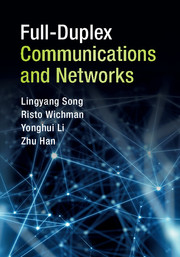Book contents
- Frontmatter
- Dedication
- Contents
- Preface
- 1 Basics of Communication Systems
- 2 Signal Processing and Theoretical Limits
- 3 Full-Duplex System Hardware Implementation
- 4 Full-Duplex MIMO Communications
- 5 Full-Duplex OFDMA Communications
- 6 Full-Duplex Heterogeneous Networks
- 7 Full-Duplex Cooperative Networks
- 8 Full-Duplex Cognitive Radio Networks
- 9 Full-Duplex Random Access Networks
- References
- Index
2 - Signal Processing and Theoretical Limits
Published online by Cambridge University Press: 16 March 2017
- Frontmatter
- Dedication
- Contents
- Preface
- 1 Basics of Communication Systems
- 2 Signal Processing and Theoretical Limits
- 3 Full-Duplex System Hardware Implementation
- 4 Full-Duplex MIMO Communications
- 5 Full-Duplex OFDMA Communications
- 6 Full-Duplex Heterogeneous Networks
- 7 Full-Duplex Cooperative Networks
- 8 Full-Duplex Cognitive Radio Networks
- 9 Full-Duplex Random Access Networks
- References
- Index
Summary
Mitigation of self-interference is the prime challenge in making full-duplex technology feasible in wireless communications. However, self-interference poses a difficult problem in general and is not limited to full-duplex communications. A wireless transceiver may suffer from self-interference even when transmit and receive frequencies are not the same, because signal from the transmitted chains leaks into the receiver chain inside the device. For this reason, 2G GSM handsets do not transmit and receive during the same time slot, although uplink and downlink frequencies are different, as in Frequency Division Duplex (FDD) systems. This is possible because one frame in GSM is divided into eight time slots, each slot is used by a different user, and uplink and downlink transmissions by one user take place in different slots.
Limiting the number of available slots for communication naturally limits the data rates of a user, and in the next generation this limitation was relaxed. In 3G WCDMA, handsets are able to transmit and receive simultaneously in FDD mode. This causes self-interference inside a device when the transmitted signal leaks in the circuit board to the receiver chain. As a matter of fact, 3G handsets require a duplex filter, making the implementation more complex and expensive than that of GSM. Thus, mitigation of self-interference is required also when using different frequencies for transmission and reception in handsets.
On the base station side, co-siting of WCDMA-TDD and WCDMA-FDD base stations operating on adjacent frequencies is not considered commercially viable [110] due to the mutual interference. This has been further observed in [111], concluding that 4G LTE-TDD adjacent band interference is harmful to uplink LTE-FDD received signals when the LTE-TDD network operates in the 1900–1920 MHz band and LTE-FDD above the 1920 MHz band. Thus, self-interference is also a problem in base stations when transmit and receive bands are different but close to each other. Therefore, selfinterference cancellation techniques developed for in-band full-duplex communication can be useful for wireless transceivers in general.
In this chapter, we first present a system model of a wireless communication link employing a full-duplex transceiver. Then we present signal processing techniques in digital baseband that aim to mitigate self-interference. In addition to digital cancellation, other necessary techniques to mitigate self-interference are antenna isolation between transmitter and receiver antennas, and different analog cancellation techniques.
Information
- Type
- Chapter
- Information
- Full-Duplex Communications and Networks , pp. 50 - 89Publisher: Cambridge University PressPrint publication year: 2017
